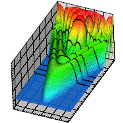Department of Physics and Astronomy: Publications and Other Research

Anthony F. Starace Publications
ORCID IDs
J M Ngoko Djiokap https://orcid.org/0000-0003-4702-3544
Document Type
Article
Date of this Version
10-30-2017
Citation
Journal of Optics 19 (2017) 124003 (16pp). doi: 10.1088/2040-8986/aa8fc0
Abstract
We study two-photon double ionization (TPDI) of helium by a pair of time-delayed (non-overlapping), oppositely circularly-polarized attosecond pulses whose carrier frequencies are resonant with 1Po doubly-excited states. All of our TPDI results are obtained by numerical solution of the two-electron time-dependent Schrödinger equation for the six-dimensional case of circularly-polarized attosecond pulses, and they are analyzed using perturbation theory (PT). As compared with the corresponding nonresonant TPDI process, we find that the doubly-excited states change the character of vortex patterns in the two-electron momentum distributions for the case of back-to-back detection of the two ionized electrons in the polarization plane. The doubly-excited states also completely change the structure of fixed-energy, two-electron angular distributions. Moreover, both the fixed-energy and energy-integrated angular distributions, as well as the two-electron energy distributions, exhibit a periodicity with time delay τ between the two attosecond pulses of about 69 as, i.e. the beat period between the (2s2 p)1Po doubly-excited state and the He ground state. Using PT we derive an expression for an angle-integrated energy distribution that is sensitive to the slower beat period ∼1.2 fs between different doubly-excited states as well as to the long timescale ∼17 fs of autoionization lifetimes. However, with our current computer codes we are only able to study numerically the time-dependent phenomena occurring on an attosecond time scale.
Included in
Atomic, Molecular and Optical Physics Commons, Elementary Particles and Fields and String Theory Commons, Plasma and Beam Physics Commons


Comments
© 2017 IOP Publishing Ltd